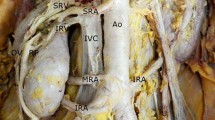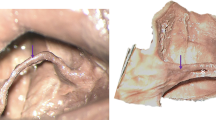Summary
The highly complex embryological development of the left renal vein compared to its right counterpart results in greater variations which are clinically significant. The study aimed to identify these variations and to document its incidence. Cadaveric study: 153 kidney pairs were harvested en bloc, dissected, 100 resin casts prepared and 53 plastinated; renal venography performed on further 58 adults and 20 foetal cadavers. Clinical study: (retrospective analysis): a) radiological study, 104 renal venograms; b) live related renal transplantation, 148 donor left kidneys; c) abdominal aortic aneurysm surgery, 525 patients. Total sample size: 1008. Renal collars observed in 0.3%; retro-aortic vein 0.5%; additional veins 0.4%; posterior primary tributary 23.2%, (16.7% Type IB; 6.5% Type IIB, cadaveric series, only). Our results differ significantly in incidence to that reported in the literature: renal collar 0.2–30%; retro-aortic vein 0.8–7.1%; additional renal vein 0.8–6%. Variations are clinically silent and remain unnoticed until discovered during venography, operation or autopsy. To a transplant surgeon, morphology acquires special significance, since variations influence technical feasibility of operation. Prior knowledge of circum-aortic vein is important when blood samples from suprarenal or renal veins are collected. Collar may provide developed collateral pathway immediately after surgery if renal interruption planned without awareness of its presence. Variations restrict availability of vein for mobilisation procedures. In aortic aneurysm repair, retro-aortic vein is important. During retroperitoneal surgery, the surgeon may visualise a pre-aortic vein but be unaware of an additional retroaortic component or a posterior primary tributary, and may avulse it while mobilising the kidney or clamping the aorta.
Résumé
Du développement embryologique très complexe de la veine rénale gauche, comparé à son homologue droit, il résulte d'importantes variations, significatives du point de vue clinique. Le but de cette étude est d'identifier ces variations et de préciser leur fréquence. 1-Recherches cadavériques : (153 paires de reins ont été prélevées en bloc, disséquées) 100 moulages par résines et 53 plastinations. En outre, des phlébographies rénales post-mortem ont été réalisées, 58 chez des adultes, 20 chez des fœtus. 2-Etudes cliniques (analyse rétrospective) : a) radiologiques : 104 veinogrammes rénaux, b) lors de transplantations rénales : 148 reins gauches de donneurs, c) au cours de la chirurgie de l'anévrysme de l'aorte thoracique : 525 patients. Soit, au total, 1008 reins. Le collier rénal a été observé dans 0,3 % de la série ; la v. rétro-aortique, 0,5 %, des vv. rénales supplémentaires : 0,4 % ; enfin, un collecteur rénal postérieur existait dans 23,2 % des séries cadavériques (16,7 % du type IB de notre classification et 6,5 % du type II B). Nos résultats diffèrent de façon significative par leur faible fréquence de celle relatée dans la littérature : collier rénal (0,2–30 %), veine rétro-aortique (0,8–7,1 %), veine rénale supplémentaire (0.8–6%). Les variations sont silencieuses cliniquement et demeurent méconnues jusqu'à leur découverte par phlébographie, opération ou autopsie. Pour le chirurgien transplanteur, la morphologie a une signification particulière puisque les variations déterminent la faisabilité technique ou non de l'opération. La connaissance préalable de la veine circum-aortique est importante lors du prélèvement d'échantillons sanguins des veines surrénaliennes ou rénales. Le collier rénal peut favoriser la formation d'un réseau collatéral dense immédiatement après l'opération, si l'interruption de la veine rénale est pratiquée sans connaissance de ce dispositif. Les variations restreignent l'utilisation de la veine dans les techniques de mobilisation. Lors de la cure d'un anévrysme aortique, l'existence d'une veine rétro-aortique est importante à connaitre. Lors d'une intervention rétro-péritonéale, le chirurgien repère la veine pré-aortique, mais il méconnait une branche rétro-aortique supplémentaire, ou un tronc primaire postérieur qu'il peut léser en mobilisant le rein ou en clampant l'aorte.
Similar content being viewed by others
References
Anson BJ, Richardson GA, Minear WL (1936) Variations in the number and arrangement of the renal vessels: A study of the blood supply of 400 kidneys. J Urol 36: 211–219
Anson BJ, Cauldwell EW (1947) The pararenal vascular system: A study of 425 anatomical specimens. Quarterly Bull North Western Univ Med School 21: 320–328
Anson BJ, Daseler EH (1961) Common variations in renal anatomy affecting blood supply, form and topography. Surg Gynecol Obst 112: 439–449
Beckmann CF, Abrams HL (1979) Circumaortic venous ring: incidence and significance. AJR 132: 561–565
Beckmann CF, Abrams HL (1980) Renal venography: Anatomy, technique, applications, analysis of 132 venograms, and a review of the literature. Cardiovasc Intervent Radiol 3: 45–70
Brener BJ, Darling RC, Frederick PL, Linton RR (1974) Major venous anomalies complicating abdominal aortic surgery. Arch Surg 108: 159–165
Chuang VP, Mena CE, Hoskins PA (1974) Congenital anomalies of the left renal v.: angiographic consideration. Br J Radio 47: 214–218
Davis CJ, Lundberg GD (1968) Retro-aortic left renal vein: A relatively frequent anomaly. Am J Clin Path 50: 700–703
Davis RA, Milloy FJ, Anson BJ (1958) Lumbar, Renal and Associated parietal and visceral veins based upon a study of 100 specimens. Surg Gynecol Obst 107: 1–22
Eisendrath DN (1920) The relation of variations in the renal vessels to pyelotomy and nephrectomy. Ann Surg 71: 726–743
Fagarasanu I (1938) Recherches anatomiques sur la veine rénale gauche et ses collatérales. Ann Anat Pathol 8: 15
Ferris EJ, Vittenberger FJ, Bryne JJ, Nasbeth DC, Shapiro JH (1967) The inferior vena cava after ligation and plication. Radiology 89: 1–10
Field S, Saxton H (1974) Venous anomalies complicating left adrenal catherisation. Br J Radio 47: 219–225
Froriep A, Froriep L (1895) Über eine verhältnismässig häufige Varietät und Bereich der unteren Hohlvene. Anat Anz 10: 574–583
Gérard G (1920) Mention d'une anastomose veineuse rénocave rétro-aortique oblique descendante. C R Soc Biol 83: 185–186
Gillot C (1978) The left renal vein: anatomical study, angiographic aspects and surgical approach. Anat Clin 1: 135–156
Gurewich V, Thomas DP, Robinson KR (1966) Pulmonary embolism after ligation of the inferior vena cava. N Engl J Med 274: 1350–1354
Hoeltl W, Hruby W, Aharinejad S (1990) Renal vein anatomy and its implications for retroperitoneal surgery. J Urol 143: 1108–1114
Hovelacque A (1914) Note sur les origines de la veine grande azygos et de l'heime inférieure et sur leurs rapports avec le diaphragme. Biblio Anat 24: 204–210
Huntington GS, McClure CFW (1907) The interpretations of variations of the post cava and tributaries of the adult cat, based on their development. Anat Rec 1: 33
Jeanbrau E, Desmonts C (1910) Contribution à la du pédicule vasculaire du rein. Bull Soc Anat 85: 669–692
Katoh N, Ono Y, Kinukawa T (1995) Efficacy of a retroperitoneal approach in a laparoscopic nephrectomy for benign renal disease, part 2, Abstract 1002. J Urol 153: 497A.
Kramer B, Grine FE (1980) The incidence of the renal venous collar in South African Blacks. S Afr Med J 57: 875–876
Krause RJ, Cranley JJ, Hallaba MA, Strusser EJ, Hafner CD (1963) Caval ligation in thromboembolic disease. Arch Surg 87: 184–192
McClure CFW, Butler EG (1925) The development of the vena cava inferior in man. Am J Anat 35: 331–383
Merklin RJ, Michels NA (1958) The variant renal and suprarenal blood supply with data on the inferior phrenic, ureteral and gonadal arteries. J Int Coll Surg 29: 41–76
Mitty HA (1975) Circum-aortic renal collar. A potentially hazardous anomaly of the left renal vein. Am J Roentgenol 125: 307–310
Nishimura Y, Fushik M, Yoshida M, Nakamura K, Imai M, Ono T, Morikawa S, Hatayama T, Komatz Y (1986) Left renal vein hypertension in patients with left renal bleeding of unknown origin. Radiology 160: 663–667
Ortmann R (1968) Über Bedeutung Häufigkeit und Variationsbild der linken retroaortaren Nierenvenen. Z Anat Entwicklungsgesch 127: 346–358
Piccone VA, Vital E, Yarnoz M, Glass P, Leveen HH (1970) The late results of the caval ligation. Surgery 68: 980–998
Pick JW, Anson BJ (1940) The renal vascular pedicle: An anatomical study of 430 body-halves. J Urol 44: 411–434
Pollak R, Prusak BF, Mozes MF (1986) Anatomic abnormalities of cadaver kidneys procured for purposes of transplantation. Am Surg 52: 233–235
Reis RH, Esenther G (1959) Variations in the pattern of renal vessels and their relation to the type of posterior vena cava in man. Am J Anat 104: 295–318
Ross JA, Samuel E, Millar DR (1961) Variations in the renal vascular pedicle (an anatomical and radiological study with particular reference to renal transplantation). Br J Urol 33: 478–485
Royal SA, Callen PW (1979) CT Evaluation of anomalies of the inferior vena cava and left renal vein. AJR 132: 759–763
Royster TS, Lacey L. Marks RA (1974) Abdominal aortic surgery and the left renal vein. Am J Surg 127: 552–554
Rupert RR (1915) Further study of irregular kidney vessels as found in one hundred cadavers. Surg Gynecol Obstet 21: 471–480
Satyapal KS (1995) Classification of the drainage patterns of the renal veins. J Anat 186: 329–333
Satyapal KS, Rambiritch V, Pillai G (1995) Additional renal veins: Incidence and morphometry. Clin Anat 8: 51–55
Seib GA (1934) The azygos system of veins in American whites and American negros, including observations on the inferior caval venous system. Am J Phys Anthrop 19: 39–159
Thomas TV (1970) Surgical implications of retro-aortic left renal vein. Arch Surg 100: 738–740
Tompsett DH (1970) Anatomical techniques, 2nd edn. E and S Livingstone, Edinburgh, London, pp 93–180
Turgut HB, Bircan MK, Hatipõglu ES, Dogruyol S (1996) Congenital anomalies of the left renal vein and its clinical importance: A case report and review of literature. Clin Anat 9: 133–135
von Hagens G (1985) Heidelberg plastination folder collection of technical leaflets for plastination. Anatomisches Institut 1, Universität Heidelberg
Warren WD, Salaam AA, Faraldo A, Huttson D, Smith BB (1972) End renal vein-to-splenic vein shunts for total or selective portal decompression. Surgery 72: 995–1006
Weinstein BB, Countis EH, Derbes VJ (1940) The renal vessels in 203 cadavers. Urol Cutaneous Rev 44: 137–139
Zumstein J (1896) Zur Anatomie und Entwicklung des Venensystems des Menschen. 1. Ueber die Beziehungen der Vena cava inferior und ihrer Aeste zu der Vena azygos und hemiazygos beim Neugeborenen und beim Erwachsenen. Hefte 1, Abt, Part 6 Anatomische: pp 571–608
Author information
Authors and Affiliations
Rights and permissions
About this article
Cite this article
Satyapal, K.S., Kalideen, J.M., Haffejee, A.A. et al. Left renal vein variations. Surg Radiol Anat 21, 77–81 (1999). https://doi.org/10.1007/BF01635058
Received:
Accepted:
Issue Date:
DOI: https://doi.org/10.1007/BF01635058




